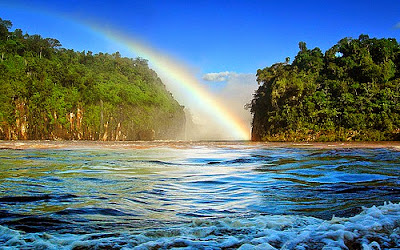 |
| Waterfalls at Paraná, Brazil / Miquitos CC BY-SA2.0 |
Are you planning a
vacation to Brazil? Maybe you are going the 2016 Summer
Olympics or just a vacation. Brazil has many places to visit from the beaches
to the Amazon rainforest. This visitor's guide to Brazil will give you helpful facts and tips that
will make your vacation more enjoyable.
What You Need to Know When Visiting Brazil
All countries have their embassy in Brasilia
and the U.S.
also has consulates in Rio de Janeiro
and Sao Paulo. Other helpful facts about Brazil are:
- The official language of Brazil is Portuguese, but English and Spanish are also spoken.
- Residents of the United States and Canada will need a visa to enter Brazil. It can take as long as 2 weeks to have the visa processed.
- It is best to buy maps for the cities you will be visiting before you go.
- For emergencies, call 190 for the police and 193 for the fire department or ambulance.
- The water in Brazil is normally safe to drink, but it is still best to drink bottled or filtered water.
- It is advisable to use your credit card or an ATM. Most banks might not cash Travelers Checks and most retailers will not take them.
- The voltage in Brazil ranges from 100 to 240 volts and 50-60 Hz with power surges. Their AC outlets are usually three prongs with two round and one flat prongs. Make sure to bring enough electrical adapters for everything you will need to plug in.
Traveling in Brazil
When traveling between cities, there are
no long distance trains in Brazil,
so your best bet getting between cities is to either fly or take buses.
According to Frommers.com, there are several things to plan
for when flying in Brazil.
Try to avoid connecting through Sao Paulo,
which might be hard to do. If you have to, plan for a 2-3 hour delay. Don’t
book overly tight connections and try to travel early in the day as backups
build up throughout the day. If you plan to travel a lot, visitors can purchase
an air pass with Tam.
Renting a car and driving yourself around is not recommended
in the cities where driving has been compared to a competitive sport with few
rules.
 |
| Serra dos Orgaos, Brazil / Jimfbleak CC BY-SA 3.0 |
The Food of Brazil
Brazilians love their meat and you will find plenty of it at
Brazilian restaurants. Grilled beef or meat, known as churrasco, is served in most
restaurants. Being a country with many climates, you can also find plenty of
fresh fish, pasta, vegetables and fruits.
Staying Safe in Brazil
There is crime in Brazil
like anywhere else. When walking around, stay in areas with heavy foot traffic.
You only need to take a copy of your passport for ID unless you are buying an
airline ticket or large purchases. Use a fanny-pack to carry money and cards
and monitor your bank accounts after using an ATM.
If you need the police, Brazil
has special tourist police stations that can take special care to help tourists
that are bilingual. The U.S.
encourages all Americans traveling to Brazil
to sign up with the embassy.
The Climate of Brazil
Brazil
is a large country with different climates that range from coastal beaches to
the Amazon rain forests. Since Brazil is in the southern hemisphere, their
seasons are reversed from what they are in the United States, but their winters
are much milder.
In July, coastal cities like Rio de Janeiro
have an average high of 67° F (19° C) and an average low temperature of 61° F
(16° C) but it can get cooler.
Copyright © 2014 Sam Montana
More Vacation Ideas:
No comments:
Post a Comment